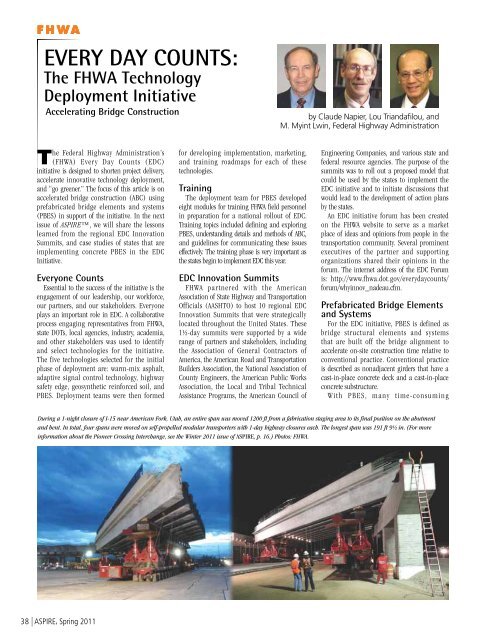ASPIRE Spring 11 - Aspire - The Concrete Bridge Magazine
ASPIRE Spring 11 - Aspire - The Concrete Bridge Magazine
ASPIRE Spring 11 - Aspire - The Concrete Bridge Magazine
You also want an ePaper? Increase the reach of your titles
YUMPU automatically turns print PDFs into web optimized ePapers that Google loves.
FHWAEvery Day Counts:<strong>The</strong> FHWA TechnologyDeployment InitiativeAccelerating <strong>Bridge</strong> Constructionby Claude Napier, Lou Triandafilou, andM. Myint Lwin, Federal Highway Administration<strong>The</strong> Federal Highway Administration’s(FHWA) Every Day Counts (EDC)initiative is designed to shorten project delivery,accelerate innovative technology deployment,and “go greener.” <strong>The</strong> focus of this article is onaccelerated bridge construction (ABC) usingprefabricated bridge elements and systems(PBES) in support of the initiative. In the nextissue of <strong>ASPIRE</strong>, we will share the lessonslearned from the regional EDC InnovationSummits, and case studies of states that areimplementing concrete PBES in the EDCInitiative.Everyone CountsEssential to the success of the initiative is theengagement of our leadership, our workforce,our partners, and our stakeholders. Everyoneplays an important role in EDC. A collaborativeprocess engaging representatives from FHWA,state DOTs, local agencies, industry, academia,and other stakeholders was used to identifyand select technologies for the initiative.<strong>The</strong> five technologies selected for the initialphase of deployment are: warm-mix asphalt,adaptive signal control technology, highwaysafety edge, geosynthetic reinforced soil, andPBES. Deployment teams were then formedfor developing implementation, marketing,and training roadmaps for each of thesetechnologies.Training<strong>The</strong> deployment team for PBES developedeight modules for training FHWA field personnelin preparation for a national rollout of EDC.Training topics included defining and exploringPBES, understanding details and methods of ABC,and guidelines for communicating these issueseffectively. <strong>The</strong> training phase is very important asthe states begin to implement EDC this year.EDC Innovation SummitsFHWA partnered with the AmericanAssociation of State Highway and TransportationOfficials (AASHTO) to host 10 regional EDCInnovation Summits that were strategicallylocated throughout the United States. <strong>The</strong>se1½-day summits were supported by a widerange of partners and stakeholders, includingthe Association of General Contractors ofAmerica, the American Road and TransportationBuilders Association, the National Association ofCounty Engineers, the American Public WorksAssociation, the Local and Tribal TechnicalAssistance Programs, the American Council ofEngineering Companies, and various state andfederal resource agencies. <strong>The</strong> purpose of thesummits was to roll out a proposed model thatcould be used by the states to implement theEDC initiative and to initiate discussions thatwould lead to the development of action plansby the states.An EDC initiative forum has been createdon the FHWA website to serve as a marketplace of ideas and opinions from people in thetransportation community. Several prominentexecutives of the partner and supportingorganizations shared their opinions in theforum. <strong>The</strong> internet address of the EDC Forumis: http://www.fhwa.dot.gov/everydaycounts/forum/whyinnov_nadeau.cfm.Prefabricated <strong>Bridge</strong> Elementsand SystemsFor the EDC initiative, PBES is defined asbridge structural elements and systemsthat are built off the bridge alignment toaccelerate on-site construction time relative toconventional practice. Conventional practiceis described as nonadjacent girders that have acast-in-place concrete deck and a cast-in-placeconcrete substructure.With PBES, many time-consumingDuring a 1-night closure of I-15 near American Fork, Utah, an entire span was moved 1200 ft from a fabrication staging area to its final position on the abutmentand bent. In total, four spans were moved on self-propelled modular transporters with 1-day highway closures each. <strong>The</strong> longest span was 191 ft 9½ in. (For moreinformation about the Pioneer Crossing Interchange, see the Winter 20<strong>11</strong> issue of <strong>ASPIRE</strong>, p. 16.) Photos: FHWA.38 | <strong>ASPIRE</strong>, <strong>Spring</strong> 20<strong>11</strong>
















